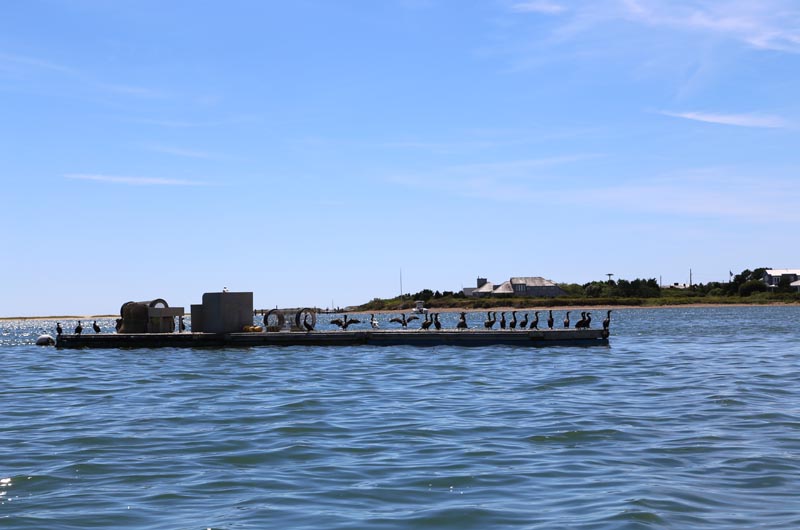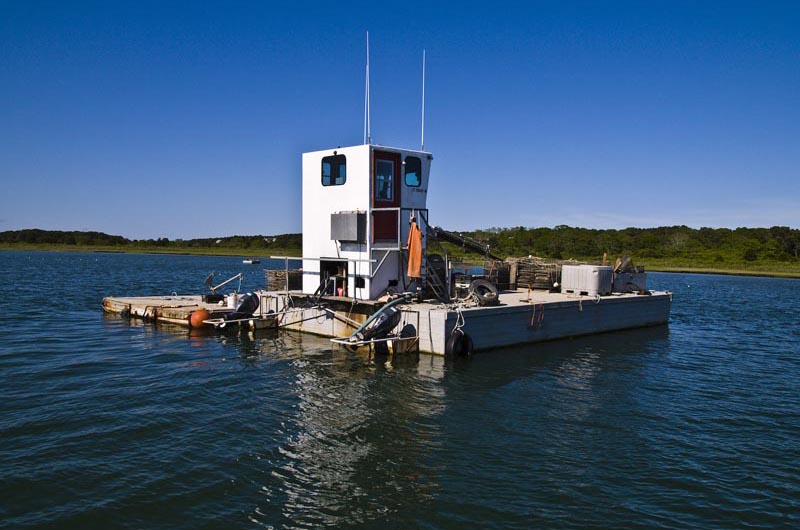Katama Bay oyster farms in Edgartown were closed this week after two people who ate oysters from the bay contracted Vibrio parahaemolyticus (Vp).
The Massachusetts Department of Public Health and the Department of Fish and Game, Division of Marine Fisheries announced the closure Monday. Katama Bay is home to 12 active independent oyster farming operations. Edgartown shellfish constable Paul Bagnall said Monday that about five million oysters are harvested from the bay in a year; last year 5,500 bushels valued at $1.1 million came out of the bay.
State officials told the Gazette Thursday that they expected the closure to last at least one month.
According to a state DPH official, the Vp cases came from oysters consumed at two Island restaurants; the state has confirmed that the restaurants did not cause the illness. The closure comes as cases of Vp are on the rise throughout the east coast, and it is the second Massachusetts oyster area closure this summer. In late August, oyster beds in Plymouth Harbor, Kingston Bay and Duxbury bay were closed due to Vp.
“The decision to close the beds was reached in consultation between DPH, DMF and the U.S. Food and Drug Administration,” a press release from the state agencies said. “We recognize the impact these actions have on many of our local businesses, and we do not take them lightly.”
Both people who consumed the oysters and became ill have recovered, state officials said.
After those cases were tied to oysters from Katama Bay, the oyster farms were closed and all product recalled. Oysters purchased from Katama Bay from August 1 to Sept. 9 can be returned and harvesting oysters from the bay is prohibited at this time.
Vibrio is a naturally occurring bacterial pathogen that increases in warmer water. Martha’s Vineyard Shellfish Group director Rick Karney, who said the bacteria is “ubiquitous,” said that to his memory, this is the first time there has been a reported case of Vp on the Vineyard.
Vp causes gastrointestinal illness, often with abdominal cramping, nausea, vomiting, fever and chills. Severe disease is rare and occurs more commonly in people with weakened immune systems. To prevent the occurrence of the bacteria, oyster harvesters must quickly refrigerate their catch, and the oysters must be cooled to an internal temperature of 50 degrees or below within 10 hours of harvest.
According to the DPH, there have been 50 reports of confirmed Vp in state residents since May 31, 2013, with 31 of those cases linked to consumption of raw oysters from Massachusetts growing areas. In the same time period last year, the state said, there were 27 cases.
Last April, the state instituted a Vp control plan for oysters harvested from May 24 through Oct. 20. The plans require that oysters be adequately iced immediately after harvest. Under state law, harvesters are required to tag oysters with information including the source and the date the oyster was taken from the water. Harvesters also are required to keep a bound harvest log book, and dealers must keep detailed records.
Suzanne Condon, director of the bureau of environmental health at the DPH, said 27 states that harvest or ship shellfish have signed onto regulations that require a growing area to be closed if two or more people are sickened from shellfish coming from that area.
The regulations also stipulate steps toward reopening the area, she said. There must be a two-week period with no new cases of illness tied to the growing area and demonstration that water temperatures are declining. The third criterion is most time-consuming: testing oysters for Vibrio levels. She said tests are sent to a lab in New York state and the DMF’s own lab. “The sampling that we’ll be doing of oysters from Katama Bay will be taken from the areas that were identified as being a source area for the oysters that people consumed,” she said.
“We’re looking at, best case scenario, about a month of closure,” Ms. Condon said. “At worst case, perhaps another week or two . . . we’re working as fast as we can.”
She said the DPH is doing disease surveillance and “that shouldn’t be too tough a test to pass. And water temperatures are likely already declining as the summer nears an end.”
Ms. Condon said there is certainty that the oysters that led to Vp came from the Katama Bay, though she noted that there are several oyster farmers in the area.
The oysters were consumed from two Vineyard restaurants, she said. “We know that in these two cases there was no abuse at the retail level, at the restaurants,” she said. “Our inspectors went over . . . we know this wasn’t something where the oysters were left out too long at the restaurant.”
For a confirmed case of Vp, those who are sick must go to the doctor or hospital and have a sample tested. According to the Centers for Disease Control, Ms. Condon said, for every confirmed diagnosis of Vp there are 142 people that likely also got sick but did not seek medical attention.
“Which harvester it was is almost not as important as the growing area itself,” Ms. Condon said. “Vibrio itself is in the water. If all [the harvesters] are following the same plan, it should be in many of the oysters.” She said it could be that one person didn’t react as quickly or take the same precautions.
She confirmed that Vp is more prevalent.
“It’s happening everywhere . . . Massachusetts is not alone,” Ms. Condon said. Vp has been reported in Connecticut, New Jersey, New York and Virginia. “Florida is having one of the most difficult seasons they’ve had in a long time . . . we’re seeing this all along the eastern seaboard.”
She continued: “I absolutely think it’s got a lot to do with the climate. We’re seeing much warmer temperatures than we’ve seen . . . most people attribute it to warmer waters and warmer air.”
Ms. Condon said the DPH is organizing a meeting with stakeholders and public officials on the Vineyard next week.
On the Vineyard, Mr. Bagnall said the impact might extend beyond the closure with stricter icing and harvesting regulations or closures of the bay when the water reaches certain temperatures. He added that the bacteria can be hard to prevent and that as New England oysters rise in popularity, there could be more frequent outbreaks.
“You can still be really careful every step of the way and per million servings there’s going to be one,” he said.“It’s a tough thing.” He noted that the thresholds for acceptable levels of the bacterium are extremely low, and that oysters are often served raw.
“I believe we have a safe food,” said Robert B. Rheault, a faculty member at the University of Rhode Island department of fisheries and aquaculture, executive director of the East Coast Shellfish Growers Association and a former oyster farmer. He said the number of reported illnesses are a small fraction of the thousands of meals served from the bay.
Mr. Rheault, who grew up on the Vineyard, said he was surprised to hear about Katama Bay, given that the barrier beach dividing the bay from the ocean has been breached. “You’re getting a lot more flow through there,” he said.
He said there are many factors. New, more virulent strains of the bacteria are appearing in the water, and the use of acid reducers make people more prone to infection. Doctors now have better access to cheaper diagnostic tools that can deliver results overnight. And Vp became a reportable CDC illness fairly recently, in the last 10 years. “We’re also seeing more people eating raw shellfish in the summer than ever before,” Mr. Rheault said. He noted there have also been recent Vp cases linked to clams and lobster.
He said education is important.
“We really need help getting the word out that everyone needs to be a partner in this,” he said, suggesting that people buying oysters or clams should bring a cooler and an ice pack. “Allowing them to warm up can get a perfectly safe product and turn it into something that’s not safe,” he said.
“Growers and harvesters need to be educated as well. Some of them might not have been fully compliant with all the regulations put in place in April. Everyone got the message and we’re going to see much better compliance next summer. I know most of the guys out there and I know most of them are doing the right thing.”
Oysters that are in the bay now — bags of oysters stored in crates — will be able to be sold when the closure is over. Mr. Rheault said closures are more devastating to wild oyster farmers. After an oil spill closed his Rhode Island oyster farm for three months, he recouped his losses by the end of year.
“Hopefully the same is true for Duxbury and Katama Bay,” he said. “You can’t really eat any raw food without some level of risk . . . even lettuce. You can eliminate risk but it means you’re eating cooked lettuce.”
Louis Larsen, who owns the Net Result fish market in Vineyard Haven, said Monday he had been calling restaurants that bought seafood from his market telling them to stop serving the oysters immediately. The oysters cannot be destroyed, he said, and must be returned and accounted for per state guidelines.
Mr. Larsen said he was thankful this didn’t happen during the middle of the summer season. He estimated that the store sold about 2,000 oysters last weekend, most of them already consumed. He said the infected oysters did not come through his store.
“This is the first time we’ve ever seen it here,” the longtime fishmonger said, wondering about the recent rise in Vp. He said perhaps outbreaks were identified as food poisoning in the past.
For now, Mr. Larsen said he’s looking for new oyster sources. Given the proliferation of the disease from New England on down, he is looking at bringing in Canadian oysters.











Comments (3)
Comments
Comment policy »